 As the old saying goes, “appearance is everything,” and in the case of our 1965 Mustang, Project Biting The Bullitt, we were severely lacking in the good looks department.
As the old saying goes, “appearance is everything,” and in the case of our 1965 Mustang, Project Biting The Bullitt, we were severely lacking in the good looks department.
The car has had all of its mechanicals sorted out over the last several years of its life as a StangTV project ride, with a sweet Dart Iron Eagle-based 427 stroker engine, a Paxton NOVI-2500 supercharger pushing over 10 pounds of boost (with more to come), and a street-friendly TCI Super Streetfighter 4L80E transmission providing the go-power. We’ve also completely upgraded the underpinnings with a custom independent front suspension from Total Cost Involved Engineering, a Strange Engineering nine-inch rearend housing, and Calvert Racing leaf springs to handle the thousand-horsepower mill under the hood.
Since we finally have the power and ride under control, the decision was made to completely freshen the Bullitt’s looks. The exterior had seen better days (many better days, a long time ago) and was in dire need of an upgrade. That’s where DuPont Automotive and JEP Autoworks entered the picture. The plan was hatched to lay down a brand new color scheme with Du Pont’s Thunder Cloud Metallic hue, but first the body needed to be cleaned up from years of bumps and bruises and, as we’d discover, more than one previous paint scheme.
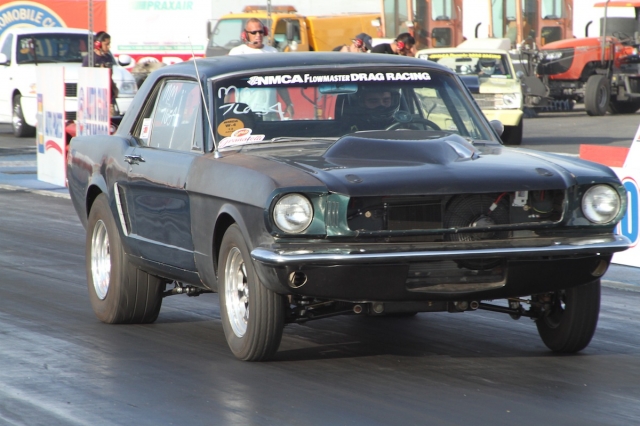
As you can see from one of our track outings late last year, Biting The Bullitt was in need of some assistance in the good looks department.
The Materials
Our materials list covers many of DuPont’s Cromax Pro line of paint products. We selected their Thunder Cloud Metallic paint to cover the flanks of Biting The Bullitt, but the product line goes much deeper than that as we needed many other materials to complete the job effectively.
The Cromax Pro line of basecoat/clearcoat paints is designed as a one-component waterborne basecoat that delivers one-and-a-half coat coverage for the majority of colors, and no flash time between coats to simplify the process. Flash time is defined as the amount of time required for the first coat of paint to dry prior to a second application, and the short (or zero) flash times required by the Cromax Pro line of paints is extremely helpful in practical use. Cromax Pro basecoat drying time will depend on several external factors like relative humidity, air flow over the paint surface, and temperature.
Along with the basecoat, we also required the WB2045 controller, WB2091 blender, and LE8700 clear to achieve our goals. Each of these components is designed to work together as a complete system.
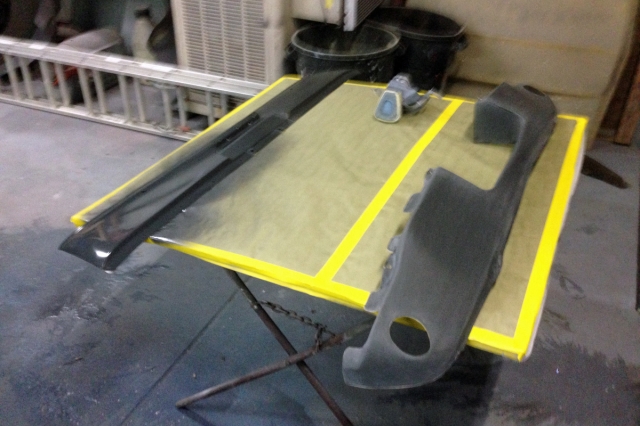
We disassembled everything we could for the fresh application of paint – it’s a critical step to ensure an even coat of paint is applied.
“Our technology is the fastest and best-coverage paint that’s out there and compliant with our regulations. Here in California we’re mandated to use water-based paints to be environmentally-friendly. It uses less material because it covers faster. The first coat is six inches per coverage and the second coat covers that immediately using a twelve-to-eighteen inch metallic orientation coat to make sure the metallics spread evenly on the surface. We use less paint to do the same job due to the pigment levels in the material. The chemistry of the paint allows it to be thicker than the other materials that are out there. The vehicle is actually covered with material with the first coat,” says DuPont’s Steven Chaparro.
“The Cromax Pro line is more painter-friendly as well. We brought people into our booth at SEMA that had never painted before and we picked up all of the twelve panels that we had in the booth and they were all laid down pretty evenly when we took them outside in the light,” Chaparro continued.
The urethane clearcoat is designed to produce a glamorous finish to meet customer expectations and offers excellent application, buff-ability, and appearance. Two medium-wet coats are applied and these need to be flashed ten to fifteen minutes between coats to achieve the proper finish. When dry, the film is 2.0-2.4 mils thick. It needs to be dried approximately sixteen hours in an air-dry situation like ours before it can be handled and requires 60 minutes to dry enough to repel dust particles.
To perform the bodywork we used the Cromax Pro LE3404S Primer Filler. It provides excellent fill capacity, is easy to apply, and sand, giving us a solid base to work from. Three wet coats are required with this product and each one needs to be flashed 8 to 10 minutes between coats. The primer should shake on a mechanical shaker prior to first usage.
Our epoxy primer sealer is the V2904S Primer Gray epoxy, which is designed for use as a metal treatment under, or as a sealer over primer surfacers. It offers superior corrosion resistance and excellent adhesion.”
The Materials List:
- Cromax Pro Mixed color 1D2 Thunder Cloud Metallic, M4610CP
- WB2045 Controller
- WB2091 Blender
- WB9908 Super Jet Black
- Cromax LE8700S Clear
- Cromax LE1007S Activator
- Cromax LE3404S Primer Filler
- Cromax LE1185S Activator
- V-2904S Primer Sealer
- V-2905S Activator
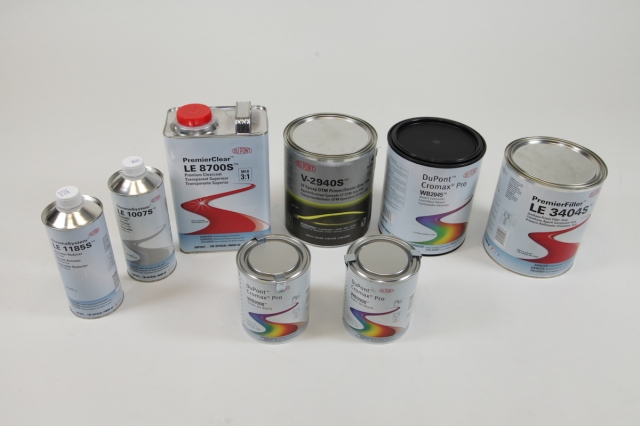
Our assortment of materials – all of the paint, primer, sealer primer, and activators in one group. Using materials from one manufacturer makes the process easier as all of the components are designed to work together.
Smoothing It Out

The JEP Autoworks team had dozens of hours in the block-sanding process which is designed to take the car down to a flat canvas. This process leaves some of the existing paint, requires body filler in some areas to be applied and sanded back down to a smooth finish, and is easily the most time-consuming part of the entire restoration process.
Before arriving at JEP Autoworks in Hemet, California, the car was disassembled. JEP then prepared for the new paint to be laid down.
“Mark brought us the car and we block-sanded the vehicle to ensure that we had a straight canvas to work with. We block-sanded with a longboard using rough 80-grit 3M sandpaper before progressing to 320-grit paper. The rough paper helps to get through the old paint more quickly, then the finer grit helps to get the rough scratches out. The purpose of block-sanding is to ensure that when you’re looking down the side of the vehicle that it’s straight and not wavy at all. There’s no way to tell how many coats of paint were on the car. We blocked it for a few days until we started seeing metal,” explains JEP’s Josh Epstein.
Before we had delivered the car, we had trimmed the wheelwells out to fit our tires underneath in the rear. The JEP team had to weld the lips back together to create a seam and tune up the look.
In addition, the front clip had already been removed along with the bumpers, trunklid, and all of the other miscellaneous parts. They also spent considerable time sanding and smoothing out the engine compartment before it was time to add the DuPont Cromax LE3404S Primer.
During the sanding process there were a number of locations that were discovered that needed some repairs. Prior to applying body filler some metalwork needed to be done to those areas to get them as flat as possible before the filler was used. Evercoat’s Z-Grip polyester body filler was applied to areas on the rear quarters and a few spots on the passenger door and subsequently sanded back down to achieve flatness in each panel.
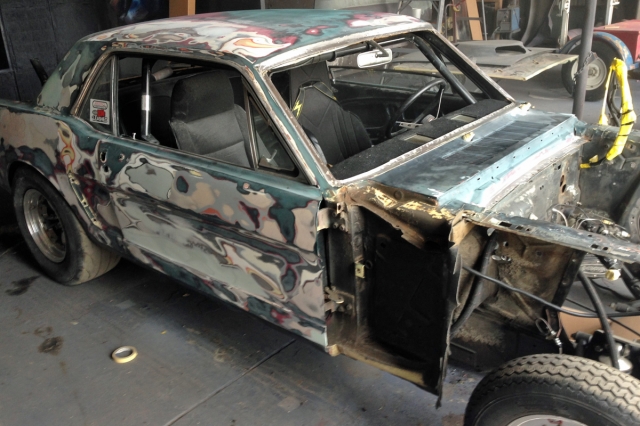
An overview of the car during the block-sanding process. Notice the multiple colors found underneath the green hue along with the body filler in spots.
Primer
You could have the best, lit-up booth in the world and you’re still going to find small imperfections in the paint during the color-sanding process. – Josh Epstein, JEP Autoworks
When they primered the car, they also laid down the primer in the engine compartment at the same time and put two heavy coats on the entire car in an effort to get a level playing field. The primer needs an activator, DuPont’s LE1185S Mid-temperature activator in this instance. The primer doesn’t work properly without the activator mixed in. It’s mixed in a 4:1 ratio of primer to activator.
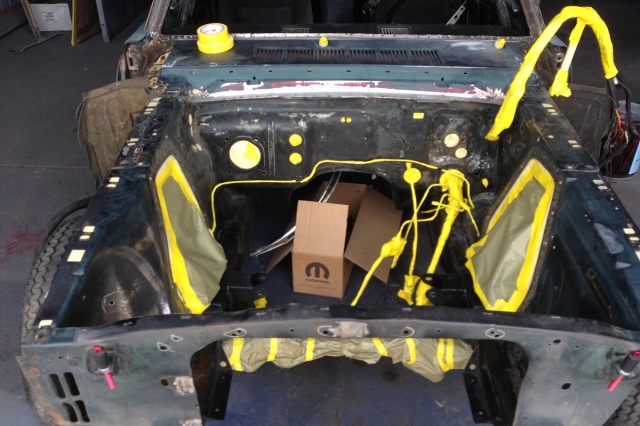
Block-sanding is complete on the engine bay, and all of our existing components are taped off to get the engine bay ready for primer.
“In a racecar like this where it’s been drilled on with self-tapping screws, and with the time constraints we had on the build, we would have had another few weeks getting the engine compartment ready. Plus the glossy black paint looks real nice with the engine in there. We also did the inner fenderwells, the bumpers, and some other items at the same time.”
Left, Middle - Once the block-sanding process is complete, the car is wiped down multiple times to ensure that there are zero contaminants on the surface, and then primer was laid down in the next step. Right - Finally, sealer primer is applied to the car in the last step before the Thunder Cloud Metallic hue is laid down. This prevents impurities from bleeding through the basecoat.
The engine compartment was subsequently taped off and protected, and the primer was block-sanded on the rest of the car to get it perfect. Once the grey primer was applied, they found a number of small issues that needed to be repaired.
A sealer primer using DuPont PN V-29040S and V-2905S Activator was applied next; its purpose is to keep any impurities from coming under the paint and gives a nice uniform color over the entire car before the paint is laid down.
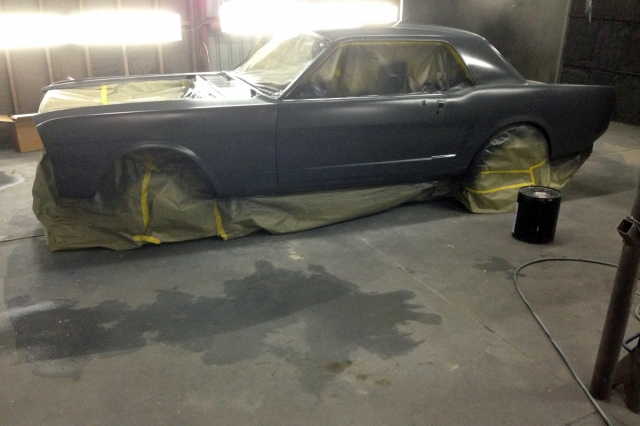
Sealer primer applied and the Bullitt is ready for the next step of the process – the Thunder Cloud metallic hue!
Preparation And Paint

Black was applied to the engine bay to make future touch-ups easier – as this car gets worked on regularly bumps and bruises are just part of the game.
After the repair and sanding process is complete, the entire car needs to be thoroughly cleaned to prepare it for the paint application.
First, the car gets blown off with compressed air to remove any sanding and body-filler dust. Then Bug & Tar and Grease Remover is applied to the entire car along with Prep-All, which is used to wipe the car down and ensure there is no dirt, dust, grease, or fingerprints on the freshly-primered-and-blocked body.
One item that Epstein stressed numerous times during our conversations is how important it is to ensure that the car is squeaky-clean; any residues will show up underneath the paint and potentially wreck an entire panel if they aren’t taken care of during the preparation process.
“All of the engine compartments of that era were a semi-flat black. We discussed the idea of doing the engine compartment in the same silver as the rest of the car, but ended up going with the black in case parts blew up or something happened in the engine compartment, we thought the black would be a lot easier to touch up,” says Epstein. Here, we used Cromax Pro WB9908 Super Jet Black paint.
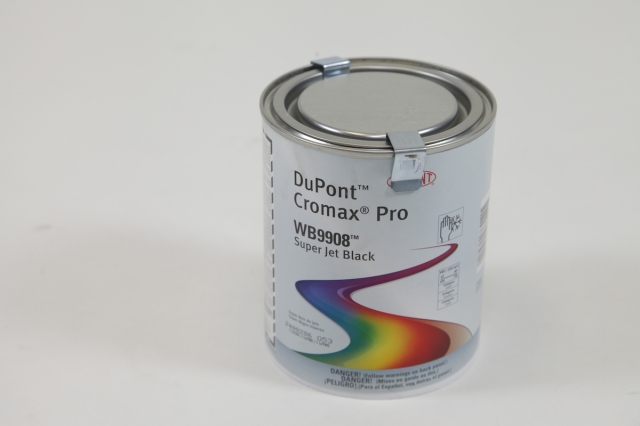
Our engine bay was finished in Super Jet Black – despite the fact that there’s no Cobra Jet powerplant between the fenders.
After this is done, the entire car gets re-taped to cover over those areas where we don’t want paint, which involves taping the doorjambs, the windows, and the trunk. To save a bit of time, the decision was made to paint the car with the doors on it, so the entire passenger area also had to be secured to prevent over spray from getting into the interior. Following the taping process, the car gets wiped down yet again with the Prep-All and air-dried to ensure it’s spotless.
“We sprayed the WB2045 DuPont controller on the car, which is what’s called a wet coat. It has to flash a little bit, maybe 15-20 minutes, and once it starts to dry you can start to spray the color. We used two one-gallon cups to mix the color and ensure that we had color to cover everything. With metallic paint, and especially with silver, if you spray at different times, the color can change. We mixed the paint to have enough to cover the doors, the trunklid, and everything else all in one shot,” says Epstein.
Paint must be thoroughly mixed with the Blender and Activator to ensure the activator is mixed in. The metallics are evenly dispersed throughout the mixture.
Wet Sanding And Final Prep
“To color sand and buff the car, it takes approximately one week with two guys on it eight hours a day. You could have the best lit-up booth in the world and you’re still going to find small imperfections in the paint during the color-sanding process. That’s why you do it,” says Epstein.
The clear was laid on thick to ensure that the team would be able to remove all of the orange-peel and other imperfections out of the clearcoat during wet-sanding. Orange peel is when the clear doesn’t lay flat, and some clearcoats lay flatter than others – it all depends on the materials used.
Depending on the car and the clear material, a small block is used with 1,000-grit and finer sandpaper in graduated steps, working back and forth in small areas, getting all of the high and low spots out of the clearcoat until it lays flat. After that, rubbing compound is applied to the entire car; subsequently the entire car is polished using yet another pad on the rotary polisher and after that a foam pad is used to polish the car and give it its final shine.
The way to combat this, according to Epstein, is to overlap each pass with the paint gun by a few inches to assure proper coverage. Once the entire car is painted, he says it’s time to fog it again to ensure that any dark and light spots come back to life in case there is any uneven coverage.
Waterborne paint is thoroughly different from the solvent-based paints of just a few years ago. Previous paints had volatile organic compounds (VOCs) that were recognized as bad for the environment and the waterborne paints are far less toxic. The waterborne paints use far less solvents, but add approximately 25% more pigments.
It also covers the car with far less material than the solvent-based paints. It takes approximately one-and-a-half coats rather than four or five depending upon the vehicle specifics and what the painter is trying to achieve.
“Paint is mixed in a 20% activator to volume of paint, and our Cromax Pro M4610CP in color code 1D2 (Toyota’s Thunder Cloud Metallic) was laid down using a SATA gun and 1.6 mm fluid tip. Paint was mixed using DuPont’s WB2091 Blender to assure a smooth mixture.”
“When you spray waterborne paints, the key is to allow the paint enough time to dry–you’re basically waiting for the water in the paint to evaporate. If it’s hotter outside it will dry more quickly and not as quickly if it’s cold. It doesn’t require a temperature-controlled booth, it’s more about keeping your area clean, wearing a paint suit, being smart about what you’re doing, keeping your stuff tied out of the way so that stuff isn’t flying off the suit into the paint, etc.” Epstein explains.
JEP Autoworks laid down approximately one-and-a-half coats of color onto the car, ensuring that any light and dark spots (tiger stripes) were touched up to ensure complete coverage of the vehicle.
Approximately one hour after the paint was laid on the car it was dry and was now time for the clearcoat to find a home on the Bullitt’s flanks. JEP used the DuPont Cromax LE8700 clear and LE1007S activator in this part of the process. Care is taken during this step to ensure that enough clear and activator is mixed together; using a SATA gun and 1.6mm fluid tip to apply the clear on top of the color. Clear to activator is also mixed in a 4:1 ratio.
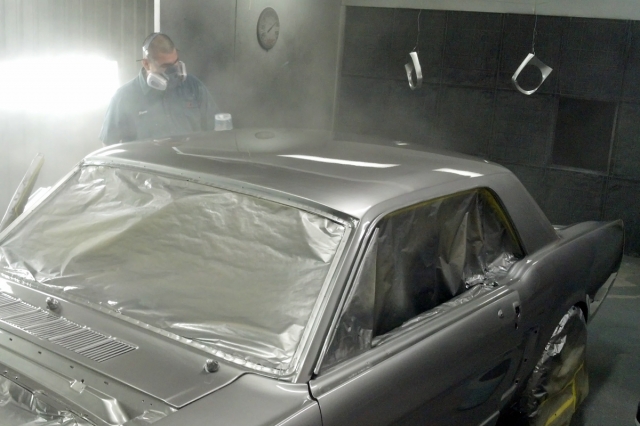
To finish out the painting process, three heavy coats of DuPont’s Cromax LE8700S Clear were applied. This gives the JEP gang plenty of cover to work with during the wet-sanding process.
Three heavy coats of clear were applied to the car, allowed to dry, and a few hours later the tape and masking materials are stripped from the car, taking care to ensure that the paint coverage is not disturbed on the paint lines.
In Conclusion
Covering the flanks of Biting The Bullitt wasn’t a one-day deal, despite what the folks at Maaco might tell you. It’s a tedious step-by-step process that requires great care at every step of the operation; as each one builds on the prior step, shortcuts can’t be taken if the end goal is to ensure a beautiful paint covering.
While the new hue on our Mustang isn’t Riddler-award quality – Epstein says that type of job takes months to do properly – it serves our purposes well and looks great from every angle, giving Project Biting the Bullitt a new lease on life from a visual perspective.





























